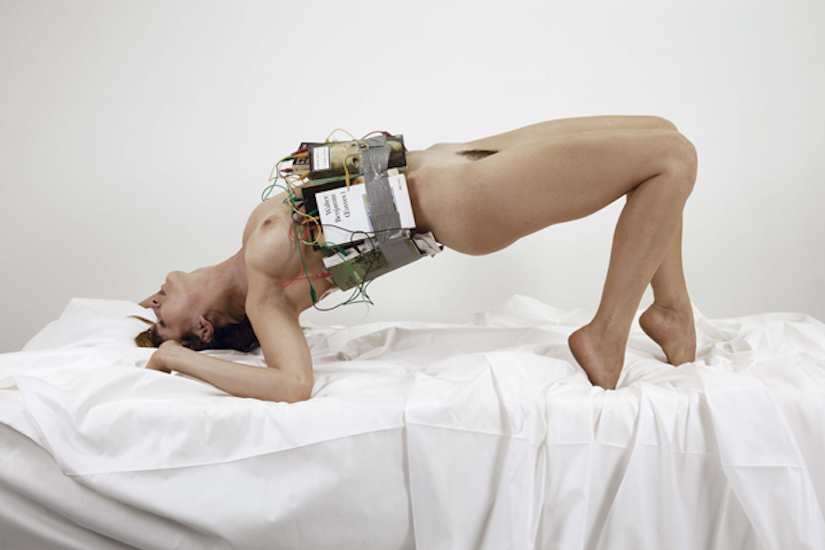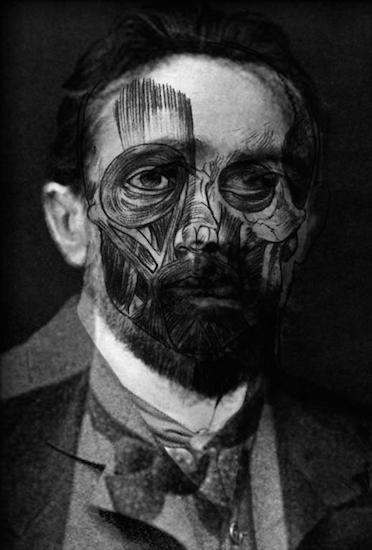
mounir fatmi, Evolution or death, 2014. Print on baryte paper, 136.5 x 205 cm. © mounir fatmi. Courtesy of the artist.
Expositions du 12/12/2014 au 18/1/2015 Terminé
CENTRE DE CRÉATION CONTEMPORAINE 55 RUE MARCEL TRIBUT 37000 TOURS France
Mounir Fatmi presents his new personal exhibition, Walking on the Light, at the CCC, Tours (France). The exhibition bring together a significant collection of about 15 recent works. The artist has given pride of place to the question of otherness and the exploration of language. He sets out a trail haunted by the presence of two writers: Salman Rushdie and John Howard Griffin—two men of language whose lives were marked by a deconstruction of their identities, and of those identities being re-created through the figure of the Other.CENTRE DE CRÉATION CONTEMPORAINE 55 RUE MARCEL TRIBUT 37000 TOURS France
The photomontage Who is Joseph Anton (2012) leads us in the footsteps of Salman Rushdie, through the pseudonym that he used to live and write during his period of enforced clandestinity. The name Joseph Anton is a contraction of the names of two other writers, Joseph Conrad and Anton Chekhov. It gives co-existence to three writers, three identities, and three voices, henceforth brought up against one another to draw a new portrait: that of the fugitive. The features of the threatened writer reappear in the video Sleep Al Naim (2005–2012), which depicts him in the ambivalence of sleep at once tranquil and disturbed, a state of vulnerability blended with strength.
Several works in the exhibition refer us to the experiments carried out in the 1960s by the white writer John Howard Griffin to melt into the black community of the USA and to share its members' experiences during a period of unfettered racial discrimination. The writer did not shrink from going as far as changing his skin colour irreversibly. His writings bore witness to that immersion in the heart of the experience of the Other, an immersion in the blackness of the image from which he would not recover.
John Howard Griffin studied medicine in Tours. He went on to do an internship under Dr. Pierre Fromenty at Tours Psychiatric Hospital, where he conducted experiments based on Gregorian music, the subjects being criminals suffering from illness. He was drafted into the army during the Second World War, during which he suffered shell-fragment injuries to the brain and was left blind. In 1957, he miraculously recovered his sight.
Bringing together those two literary evocations, mounir fatmi presents about ten works of which some, like Mehr Licht are emblematic of his works and of his quest to grasp the ungraspable. Along the way, the exhibition explores, in particular, the violence of history and of civilisation, which is expressed through the written word and in various forms of language: religious, political, and literary.
mounir fatmi was born in Tangier in 1970; he currently divides his working life between Morocco and France. His work has enjoyed international recognition since about 2005. His multimedia work blends installation, sculpture, video, drawing, painting, and writing. mounir fatmi is an artist at the junction of Western and Eastern civilisations. He develops a critical and aesthetic approach that goes against dogmas: political, religious, and social. Over and above established representations and codes, he questions the contemporary world by representing its ambiguities and its doubts, its violence and its paradoxes. His work takes the form of an immense network, and crosses a range of areas of knowledge, from the sciences to philosophy, from techniques to politics. It is a way of inviting us to read the world between the lines and to find other ways of seeing things, whilst refusing to be blinded by convention.

Mounir Fatmi 'Qui est Joseph Anton', 2012. Courtesy de Keitelman Gallery, Bruxelles

